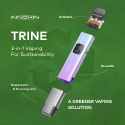In this video, I take a look at three different methods for building your wick and coil assemblies and share some of my Genesis experiences to date including some of my experience in materials, gauges, meshes, and the difference between building on a wick/coil on a mech vs. a regulated device. Note that although this video was created for the AGA-T(s), the methods can be applied to most Genesis atomizers.
My apologies for the “action” being a little off camera during some of this video. I’m working on a better method to balance my focus on the task at hand AS WELL AS keeping the action on-cam.
IMPORTANT! The Pulse method shown in this video is not exactly the safest method out there. You’re starting off with a damn near short which could be detrimental to your battery and has the potential to lead to venting. A couple tips I’ve heard, 1) Don’t use a fully charged batter, let it drain to around 3.7 volts. 2) You may want to clean or torch your mesh before rolling it to get rid of any harmful contaminants. Use these methods, like any electric cigarette device at your own risk!!
Let’s be clear, am I the best at this? No. But I continue to build my Genesis knowledge and share it with you to the best of my ability.
I pulled some information/suggestions from this video that you may want to see at a glance. Remember, these are the numbers I enjoy and may not be for everyone, not will everyone agree, and that’s ok!
- Lower the wire gauge = thicker the wire = lower resistance over a given piece of wire.
- Higher the wire gauge = thinner the wire = higher resistance over a given piece or wire.
- On a mechanical device: 28 gauge, 3 or 4 wraps, around a 1 Ohm coil.
- On a regulated device: 32 gauge, 4 or 5 wraps, around a 1.5 Ohm coil.
- Try lower density mesh (Ex: 200, 270, 325) for thicker e-liquids.
- Try higher density mesh (Ex: 400, 500, 635) for thinner e-liquids.
Those suggestions could certainly change as I learn and grow more with mechs.
The Video:
Post-Review Follow-Up:
I created a resistance wire calculator for myself and it’s been working pretty good so I decided to pretty it up a bit and share it with you guys.
It available to download by clicking HERE. Excel is required.
- Enter the target resistance of the coil you’re trying to make in the first field.
- Use the pull down in the second field to select the coil type (currently supports single, dual, and triple
- Use the pull down in the third field to select the Kanthal gauge (currently supports 28, 32, & 34 – metric also display)
- The wire length in inches, cm, and the number of wires required will be calculated for you.
Note that the calculations are based detailed resistance measurements of A-1 Kanthal I purchased from Temco on Ebay. Depending on what your using, you may need to modify the calculations a bit.
The Photos














 Store
Store








125x125.jpg)





